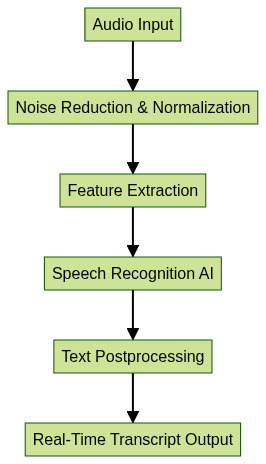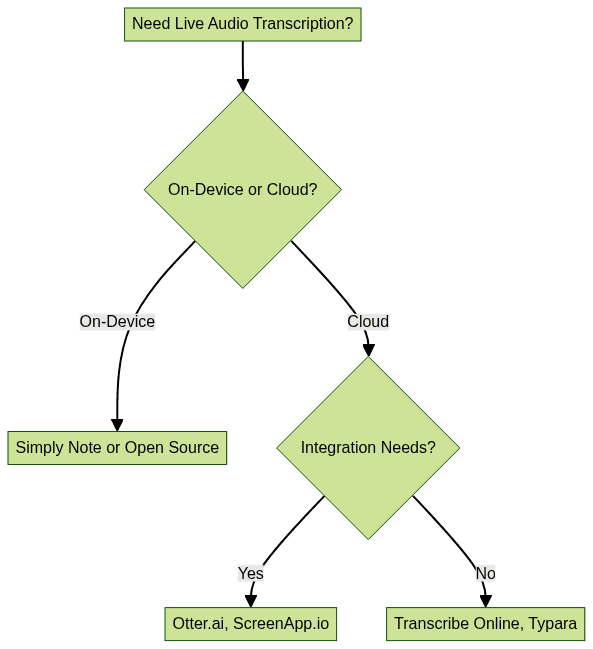Introduction to Live Audio Transcription
Live audio transcription in 2025 refers to the process of converting spoken language into written text in real-time, leveraging advanced AI, machine learning, and natural language processing (NLP) technologies. This capability has become essential for businesses, educators, journalists, and professionals seeking to enhance productivity, accessibility, and automation. From its origins in simple voice dictation software, live audio transcription has evolved rapidly, driven by advances in cloud computing and deep learning. Today, it powers everything from automated meeting minutes to real-time captioning and supports multi-language scenarios, transforming the way we interact with audio content.
How Live Audio Transcription Works
Live audio transcription captures and processes audio input in real time. At its core, the process involves:
- Audio Capture: Microphones or VoIP streams provide the live audio feed.
- Preprocessing: Noise reduction and normalization clean the signal.
- Feature Extraction: The audio waveform is analyzed to extract relevant features for speech recognition.
- Speech Recognition: AI engines convert audio features into text using models trained on vast datasets.
- Postprocessing: Formatting and punctuation are added; the output is displayed or shared in real time.
The integration of AI and NLP has revolutionized accuracy and speed in speech to text. Deep neural networks, such as those used in OpenAI Whisper and Google Speech-to-Text, enable real-time transcription even in noisy or multi-speaker environments. For developers building advanced audio applications, integrating a
Voice SDK
can streamline the process of capturing and transmitting high-quality audio for transcription.Code Snippet: Simple Python Script for Live Speech-to-Text
1import speech_recognition as sr
2
3def live_transcribe():
4 recognizer = sr.Recognizer()
5 mic = sr.Microphone()
6 with mic as source:
7 print("Listening...")
8 recognizer.adjust_for_ambient_noise(source)
9 audio = recognizer.listen(source)
10 try:
11 text = recognizer.recognize_google(audio)
12 print(f"Transcript: {text}")
13 except sr.UnknownValueError:
14 print("Could not understand audio")
15 except sr.RequestError as e:
16 print(f"API error: {e}")
17
18if __name__ == "__main__":
19 live_transcribe()
20
Key Technologies Behind Live Audio Transcription
The landscape of live audio transcription is shaped by powerful speech recognition engines like OpenAI Whisper, Google Speech-to-Text, and Microsoft Azure Speech. Developers can choose between on-device solutions for privacy and speed, or cloud-based platforms for scalability and ease of integration. Open-source projects are also gaining traction, enabling custom deployments for enterprise or research use. If you want to
embed video calling sdk
alongside transcription features, several platforms offer prebuilt solutions for rapid integration.Benefits of Live Audio Transcription
Live audio transcription offers a spectrum of advantages in modern workflows:
- Increased Productivity: Automates note-taking and meeting minutes, freeing up time for higher-value tasks.
- Accessibility: Provides real-time captions for users with hearing impairments or non-native language speakers.
- Automation: Extracts action items, summaries, or key insights from live meetings using AI.
- Multi-Language Support: Many platforms support real-time translation, enabling global collaboration and communication.
These benefits extend to industries such as healthcare, legal, education, and media, where accurate, real-time records are mission-critical. For organizations needing seamless integration with conferencing tools, leveraging a robust
Video Calling API
can enhance both live communication and transcription workflows.Use Cases for Live Audio Transcription
- Business Meetings & Remote Work: Automate the creation of meeting minutes, enable searchable transcripts, and improve compliance.
- Journalists & Content Creators: Instantly transcribe interviews, podcasts, or events for faster publishing and content repurposing.
- Students & Educators: Capture lectures, seminars, and discussions, enabling searchable study materials and inclusive learning environments.
- Researchers & Healthcare Professionals: Document interviews, patient consultations, or group studies with high accuracy and security.
Live audio transcription is also invaluable for call centers, legal proceedings, and government agencies seeking to modernize documentation processes. For those developing custom telephony solutions, integrating a
phone call api
can further streamline the process of capturing and transcribing calls in real time.Choosing a Live Audio Transcription Tool
With a growing ecosystem, selecting the right live audio transcription software requires a careful comparison:
- Otter.ai: Popular for its robust AI, collaboration features, and integration with Zoom and Google Meet.
- ScreenApp.io: Focuses on screen recordings with live transcription for training and webinars.
- Simply Note: Emphasizes simplicity and privacy with on-device processing.
- Typara: Supports real-time, multi-language transcription with advanced formatting.
- Transcribe Online: Web-based, ideal for quick, no-installation transcription needs.
If you are building custom applications, using a
python video and audio calling sdk
can help you quickly add both calling and transcription features to your workflow.Feature Checklist
- Accuracy: How reliably does it transcribe diverse accents and noisy environments?
- Integration: Can it connect with video conferencing, cloud storage, or productivity tools?
- Security: Are transcripts encrypted and compliant with standards (GDPR, HIPAA)?
- Price: Is there a free tier, or flexible billing for teams?

Integrating Live Transcription into Your Workflow
Most platforms offer APIs for real-time transcription, allowing developers to embed transcription into VoIP apps, CRM systems, or custom dashboards. Cloud storage integration (Google Drive, Dropbox) and real-time transcript sharing foster seamless collaboration and version control. When integrating, prioritize API documentation, webhook support, and data export formats for maximum workflow flexibility. For interactive broadcasts or large-scale events, a
Live Streaming API SDK
can enable real-time transcription alongside live audio and video streaming.Implementing Live Audio Transcription: Step-by-Step Guide
- Set Up Hardware & Software:
- Use a quality microphone or interface; for multi-speaker scenarios, consider omnidirectional mics.
- Deploy transcription software or libraries (OpenAI Whisper, SpeechRecognition, Vosk).
- Best Practices for Clear Audio:
- Minimize background noise, use pop filters, and record in acoustically treated spaces where possible.
- If using VoIP, ensure stable internet with low latency.
- Install and Configure Transcription Engine:
- For open-source or custom solutions, follow setup documentation and tune parameters for your use case.
For developers looking to add high-quality audio features, integrating a
Voice SDK
can simplify the process of capturing, processing, and transmitting audio for live transcription.Code Snippet: OpenAI Whisper on Raspberry Pi (C++)
1#include <iostream>
2#include "whisper.h" // Assumes OpenAI Whisper C++ library
3
4int main() {
5 Whisper whisper;
6 if (!whisper.init("model.bin")) {
7 std::cerr << "Failed to load model" << std::endl;
8 return 1;
9 }
10 std::cout << "Listening for live audio..." << std::endl;
11 whisper.listenAndTranscribe([](const std::string\& transcript) {
12 std::cout << "Transcript: " << transcript << std::endl;
13 });
14 return 0;
15}
16Privacy, Security, and Compliance in Live Audio Transcription
Handling sensitive audio data requires robust privacy and compliance measures. Always:
- Encrypt Transcripts: Use at-rest and in-transit encryption.
- Access Control: Limit permissions and audit usage logs.
- Compliance: Ensure tools meet industry standards (GDPR, HIPAA, SOC 2) for your sector.
- On-Device Processing: For maximum privacy, consider solutions that never send audio to the cloud.
Review vendor policies and data retention practices before integrating any solution into your business workflow. For applications where privacy and security are paramount, choosing a
Voice SDK
with strong encryption and compliance features is essential.Monetizing Live Audio Transcription
Opportunities abound for monetizing live audio transcription skills. Freelancers can offer transcription services via platforms like Upwork or Rev, or develop custom integrations for companies. SaaS developers can build niche transcription tools for vertical markets, or offer add-ons to existing platforms. With rising demand, transcription expertise is a valuable asset in 2025. If you’re interested in exploring these tools for your own projects, you can
Try it for free
and see how live transcription can enhance your workflow.Conclusion
Live audio transcription has transformed productivity, accessibility, and automation in countless industries. As AI and NLP models continue to improve, expect even greater accuracy, language coverage, and workflow integration. Developers and tech professionals who master these tools will unlock new efficiencies and opportunities throughout 2025 and beyond.
Want to level-up your learning? Subscribe now
Subscribe to our newsletter for more tech based insights
FAQ